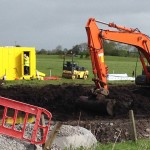Fine Gael TD for Galway West and Mayo South Seán Kyne has today (Thursday) welcomed confirmation from the Office of Public Works’ Minister, Simon Harris that the Department of Public Expenditure and Reform will this month sign off on the environmental review which has delayed works on the Claregalway Flood Relief Scheme.
Deputy Kyne raised the issue in the Dáil querying the reasons for the ongoing delay in the scheme. Progress on flood relief schemes has been impacted by new EU Environmental laws which required national government departments to review environmental impact statements carried out by agencies such as the OPW.
Commented Deputy Kyne: “I am delighted that Minister Harris has confirmed that the Department will sign off on the new Environmental Impact Assessment this month clearing the way for the works to take place on the River Clare.
“The delay to this much-needed project has never been about funding but about new obligations placed on member states by the EU Environmental directives.
“The OPW has already spent €2.5 million of the €7.1 million allocation carrying out works with which it could proceed. These included the construction of a flood eye at Claregalway bridge, the construction of a new bridge at Crusheeny, and the use of two long-reach machines to remove silt from the bends of the channel and upstream on the Clare River.
“I am encouraged by Minister Harris’ statement in the Dáil today that once the assessment is complete this month the Department will proceed with these important works without further delay. The completion of the project will provide great assurance to the residents and business-owners of the locality.”
Summary of Claregalway—River Clare Scheme Works:
The scheme primarily involves:
- Localised road raising at Miontach North and Miontach South
- Construction of a new flood eye at Claregalway Bridge (already completed), with regarding of the existing channel upstream through and downstream of the existing Claregalway Bridge
- Selective Accelerated Channel Maintenance from Lough Corrib to Cregmore Bridge
- Increase the capacity of culverts at various locations on the Kiniska and Islandmore tributaries in conjunction with channel maintenance
- Construction of a New Bridge at Crusheeny (already completed)
- Construction of a pipeline/open channel combination from A) Carnmore and Cashla areas to Islandmore channel and B) from Lakeview area to the Clare River upstream to Claregalway Bridge
- Channel widening from 1.3km upstream of Crusheeny Bridge to immediately downstream of Crusheeny Bridge to form a two-stage channel
- Construction of two embankments, one locally at the Old Nine Arch Bridge to include filling of the gap in wall at Mhainistir Estate and the other 1.3km upstream of Crusheeny Bridge to the Islandmore drain with the installation of a non-return on the outfall of the Islandmore drain.
Transcript of Dáil Questions and Reply
Deputy Seán Kyne asked the Minister for Public Expenditure and Reform, in light of the provision of funding in his departmental budget, if the River Clare drainage scheme will be proceeding, given the necessity of the works for this region; and if he will make a statement on the matter.
Deputy Seán Kyne: I raised this issue on 9th of October 2014 and I believe that we are all sitting in the same seats. According to the Minister of State at the time “The Claregalway scheme is the first flood relief scheme submitted for confirmation following the coming into effect of the 2012 regulations”, which “require my colleague, the Minister for Public Expenditure and Reform, to carry out an environmental impact assessment of drainage or flood relief schemes prior to confirmation or approval of the proposed schemes”. This has not happened. There has certainly been no confirmation. What is the delay?
Minister of State, Simon Harris: I thank Deputy Kyne for raising this question and for his persistence on what is an important matter. I confirm that the River Clare drainage scheme will be proceeding.
The Office of Public Works, OPW, in association with Galway County Council, has developed a flood relief scheme under the Arterial Drainage Acts for the River Clare in the environs of Claregalway. In recognition of the significant flooding problems in the area, it was agreed to proceed with interim measures to reduce flood risk.
In 2012, the following remedial works were carried out in advance of the main scheme works: construction of a flood eye at Claregalway bridge; and construction of new bridge at Crusheeny. These advance works have been successfully completed at a cost of €2.5 million. While they have significantly reduced flood risk in the area, they do not provide the OPW standard level of protection that the overall scheme will provide, which is to protect against the one-in-100 year flood event.
As the Deputy will be aware, a public exhibition of the River Clare scheme was held in late 2012 and stakeholders were afforded an opportunity to submit their observations on the proposals. A number of responses were received, including a detailed submission by the Department of Arts, Heritage and the Gaeltacht on nature conservation and the underwater archaeological aspects of the proposed works. Where necessary, the issues raised were considered fully by the OPW with in-depth technical input from the environmental consultants and were addressed where appropriate. The proposed scheme was subsequently approved by the OPW and submitted to the Minister for Public Expenditure and Reform in late 2013 for confirmation, that is, statutory approval.
Regulations were introduced across a number of Departments in 2012 in order to ensure that Ireland was fully compliant with EU environmental impact assessment, EIA, laws. These regulations introduced necessary changes to Departments’ EIA consent systems. In the case of flood relief schemes carried out under the Arterial Drainage Acts, the regulations require that the Minister for Public Expenditure and Reform, as the consent authority for such schemes, undertake an independent assessment of the environmental impact statement, EIS, submitted with the scheme documents by the OPW under the confirmation process. The Minister is also required to publish his decision to confirm or not to confirm a scheme and to provide for a process of appeal of his decision. The Claregalway scheme was the first scheme to be submitted under this process. I will respond further and with more detail in a moment.
Deputy Seán Kyne: I thank the Minister of State for his reply, but this information is the same that provided last year. The Claregalway scheme was the first that needed to be approved under the new regulations and the EU directive. Presumably, this means that no flood relief scheme has proceeded in the interim. They are all waiting.
People are exasperated by this situation. We are told that the money is available under the capital plan, but it was available this time last year. The scheme has been announced repeatedly, including by the Minister of State’s predecessor. People are wondering about the reason for the delay and when these schemes will be approved. Will this be the process for all future relief schemes? Will there be a couple of years of a delay or is the Minister of State still trying to fine-tune a template for approvals? Must the existing environmental impact statement, EIS, be approved or must the Department conduct an assessment of its own? There was some confusion in that regard last year, so I am wondering whether it has been decided.
Deputy Simon Harris: The Deputy is correct. As a result of the Claregalway scheme being the first, it is fair to say that it has taken longer than one would wish. We have consulted the Office of the Attorney General on putting in place an adequate, streamlined and efficient system to deal with schemes. However, there is news for the Deputy that differs from that provided last year, namely, the process in my Department will be completed in October and we are moving towards finalising the evaluation. Being the first, not only was it important to evaluate the Claregalway scheme, but also to put in place a template for further schemes. Lessons should be learned.
Following completion of the confirmation process by the Minister – assuming that it is a positive decision—and allowing the necessary time for the Department to inform the public of that decision, the OPW will be in a position to commence works on the scheme in a matter of weeks subject to their being carried out within environmental windows and satisfying any precondition that may be attached to the confirmation process. When VAT and future cost fluctuations are taken into account, the total budget for the scheme is €7.1 million, including the approximately €2.5 million that has already been expended.
Deputy Seán Kyne: I thank the Minister of State for the positive statement to the effect that the process will be completed in October. Following completion, when is it likely that a decision will be made? The major capital investments that were announced in the capital plan this week are welcome, but I would not like such delays to ensue in other projects. In that regard, it is important that schemes under the catchment flood risk assessment and management, CFRAM, programme be expedited within the environmental requirements and legislation. Sometimes, a good news story that provides relief and assurance to people can be negated by delays.
Deputy Simon Harris: I largely agree. It is important that we have systems in place to deal speedily with schemes. It is also important that the State carry out this work in accordance with the law, including our European commitments under environmental law.
I am pleased to be able to update Deputy Kyne on the significant progress that has been made with the Claregalway scheme. Under the capital plan announced by my colleague, the Minister, Deputy Howlin, this week, the Government has pledged to spend more on flood relief in the next five years than was spent in the past twenty years combined. This shows the Government’s commitment.
Maintenance works have been carried out on the River Clare. The OPW employed two long-reach machines to remove a build-up of silt from bends on both banks of the river from Lough Corrib upstream to Crusheeny Bridge. I am informed that this work has been substantially completed. The Minister has assured me that, as soon as the process is completed in the Department, there will be no delay on his end and there will be none on mine. We are eager for the scheme to progress as quickly as possible. I reiterate that the funding is in place.



